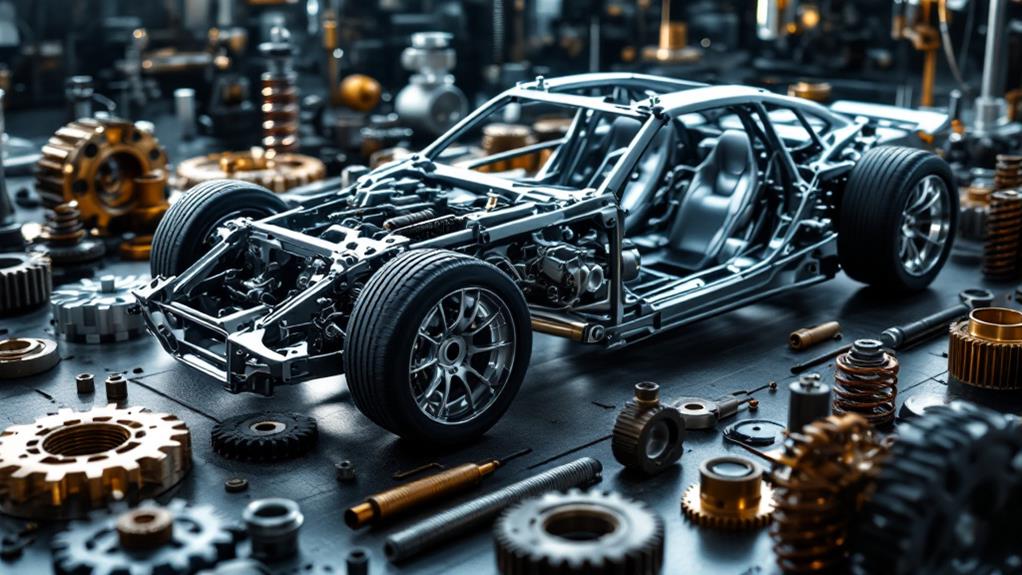Properties and Common Uses of Steel: Everything You Should Know

Steel's exceptional properties make it indispensable in various industries. You'll find it in construction, automotive, and energy sectors due to its high strength-to-weight ratio, durability, and versatility. It's composed primarily of iron and carbon, with alloying elements enhancing specific traits like corrosion resistance. Steel's tensile and compressive strength make it ideal for skyscrapers and bridges, while its malleability allows for complex shapes in vehicles. It's also recyclable, contributing to sustainable practices. From everyday items to state-of-the-art technology, steel's impact on modern life is substantial. Exploring its types and applications reveals a world of innovation and possibility.
Chemical Composition of Steel
Steel, the backbone of modern construction and manufacturing, is primarily composed of iron and carbon. The carbon content in steel typically ranges from 0.2% to 2.1% by weight, which significantly influences its properties. You'll find that the precise chemical composition of steel varies depending on its intended use and desired characteristics.
In addition to iron and carbon, steel often contains other alloying elements that enhance its performance. These may include manganese, nickel, chromium, molybdenum, and vanadium. Each element contributes unique properties to the steel. For instance, chromium increases corrosion resistance, while nickel improves toughness and ductility.
The chemical composition of steel can be further modified through heat treatment processes. These techniques alter the steel's microstructure, affecting its strength, hardness, and other mechanical properties. You can customize steel's characteristics by carefully controlling its composition and applying specific heat treatments.
Understanding the chemical makeup of steel is essential for selecting the right type for your project. Whether you need high-strength steel for construction or corrosion-resistant steel for marine applications, the composition plays a pivotal role in determining its suitability and performance.
Mechanical Properties of Steel
The mechanical properties of steel are what make it such a versatile and widely used material across various industries. You'll find that steel's exceptional strength-to-weight ratio allows it to withstand heavy loads while remaining relatively lightweight. This unique combination makes it ideal for construction, automotive, and aerospace applications.
Steel's tensile strength is particularly impressive, enabling it to resist pulling forces without breaking. You'll see this property employed in suspension bridges and high-rise buildings. Additionally, its compressive strength allows it to bear immense weight without deforming, making it perfect for load-bearing structures and machinery components.
You'll appreciate steel's ductility, which lets it bend without fracturing, and its malleability, allowing it to be shaped into various forms. These properties are indispensable in manufacturing processes. Steel also exhibits excellent fatigue resistance, meaning it can withstand repeated stress cycles without failing. This makes it essential in applications like vehicle axles and industrial machinery.
Furthermore, steel's hardness and wear resistance contribute to its longevity and durability in tools, cutlery, and heavy equipment. You'll find that these mechanical properties can be fine-tuned through heat treatment and alloying to suit specific applications.
Types of Steel

Metallurgists have categorized steel into several distinct types, each with unique properties suited for specific applications. These steel classifications encompass a wide range of steel alloy varieties, each customized to meet specific industry needs. You'll find that the most common types of steel include carbon steel, alloy steel, stainless steel, and tool steel.
Carbon steel, the most widely used type, contains varying amounts of carbon and is known for its strength and durability. Alloy steel incorporates additional elements like manganese, nickel, or chromium to enhance specific properties. Stainless steel, containing at least 10.5% chromium, offers excellent corrosion resistance. Tool steel, designed for cutting and shaping other materials, boasts high hardness and wear resistance.
Low carbon steel: Easily formable and weldable
High carbon steel: Extremely hard but brittle
Austenitic stainless steel: Non-magnetic and highly corrosion-resistant
High-speed tool steel: Maintains hardness at high temperatures
Understanding these steel alloy varieties will help you choose the right type for your specific needs, whether it's for construction, automotive manufacturing, or precision tooling.
Steel in Construction
Construction's backbone is indisputably steel, a material that has revolutionized the building industry. You'll find steel in infrastructure projects like bridges, highways, and railways, where its strength and durability are pivotal. Steel's high tensile strength allows for longer spans and taller structures, making it ideal for skyscrapers and large-scale public works.
In buildings, steel plays a paramount role in both structural and non-structural elements. You'll see it in the framework, supporting beams, and reinforced concrete. Steel's versatility allows designers to conceive innovative shapes and structures that were once impossible. It's also used in roofing, cladding, and internal fixtures.
Steel's fire resistance and ability to withstand seismic activity make it a safe choice for construction. Its recyclability and long lifespan contribute to sustainable building practices. You can easily modify and expand steel structures, making them adaptable to changing needs. With its cost-effectiveness and quick assembly time, steel has become the go-to material for both residential and commercial construction projects worldwide.
Automotive Applications

Moving from towering structures to the vehicles that traverse our roads, steel's versatility shines in automotive applications. You'll find steel in various parts of your car, from the body to the engine. Its strength, durability, and cost-effectiveness make it an ideal material for automotive manufacturers.
Steel plays an essential role in automotive body panels, providing structural integrity and safety. It's used in:
- Door frames and panels
- Roof supports
- Hood and trunk lids
- Fenders and quarter panels
In automotive engine components, steel's heat resistance and strength are irreplaceable. You'll find it in pistons, crankshafts, and valve springs. Steel's malleability allows for complex shapes, while its magnetic properties enable sensors to monitor engine performance.
Modern automotive steel is lighter and stronger than ever, thanks to advanced manufacturing techniques. This helps improve fuel efficiency without compromising safety. As you drive, you're surrounded by steel that's been carefully engineered to protect you in case of an accident. From absorbing impact energy to maintaining the passenger compartment's integrity, steel keeps you safe on the road.
Steel in Energy Production
In light of the world's growing energy needs, steel plays an essential role in various forms of energy production. You'll find steel power generation components in traditional fossil fuel plants, nuclear reactors, and renewable energy systems. Steel's strength, durability, and heat resistance make it ideal for turbines, boilers, and pressure vessels in coal and natural gas plants.
In nuclear energy, steel is fundamental for reactor vessels, containment structures, and cooling systems. It provides the necessary radiation shielding and structural integrity to guarantee safe operation.
Steel renewable energy applications are expanding rapidly. Wind turbines rely on steel for towers, nacelles, and internal components. Solar power installations use steel for mounting systems and support structures. Hydroelectric dams incorporate steel in their gates, penstocks, and turbines.
You'll also see steel in emerging energy technologies like tidal and wave power systems. Its corrosion resistance is pivotal in these harsh marine environments. As the world shifts to cleaner energy sources, steel continues to be an indispensable material, enabling the construction and operation of diverse power generation facilities.
Aerospace and Steel

The aerospace industry relies heavily on steel for its unparalleled combination of strength, weight, and reliability. You'll find steel components in various aspects of aircraft manufacturing and space exploration. From the structural framework of planes to the intricate parts of spacecraft, steel plays an indispensable role in ensuring safety and performance.
In aircraft manufacturing, steel is used for:
- Landing gear components
- Engine parts
- Hydraulic systems
- Fasteners and connectors
Steel's high strength-to-weight ratio makes it ideal for these applications, allowing aircraft to maintain structural integrity while minimizing overall weight. In space exploration, steel is leveraged in rocket engines, fuel tanks, and satellite components due to its ability to withstand extreme temperatures and pressures.
You'll also find steel in aerospace ground equipment, such as launch platforms and testing facilities. Its corrosion resistance and durability make it a preferred material for these structures exposed to harsh environments.
As aerospace technology advances, new steel alloys are being developed to meet the industry's evolving needs. These innovations continue to expand the horizons of what's possible in aircraft manufacturing and space exploration, ensuring steel remains a critical material in the aerospace sector.
Steel in Consumer Products
Countless everyday items you use rely on steel for their durability, functionality, and cost-effectiveness. From your kitchen to your garage, steel plays an indispensable role in making your life more convenient and efficient.
Home appliances are prime examples of steel's versatility in consumer products. Your refrigerator, washing machine, and dishwasher all incorporate steel components for their structural integrity and longevity. Steel's resistance to corrosion and ability to withstand high temperatures make it ideal for these appliances that endure frequent use and exposure to water.
In your toolbox, you'll find various cutting tools made from steel. Kitchen knives, scissors, and utility blades benefit from steel's hardness and ability to maintain a sharp edge. The material's strength allows for thinner, more precise blades that can tackle tough cutting tasks with ease.
Steel's presence extends to smaller items you might overlook, such as paper clips, staples, and safety pins. These everyday objects showcase steel's malleability and tensile strength, allowing them to bend without breaking. By choosing steel products, you're investing in items that will serve you well for years to come.
Recycling and Sustainability

Sustainability drives the modern steel industry, with recycling playing an important role in reducing its environmental impact. You'll find that steel is one of the most recycled materials globally, contributing considerably to a circular economy. When you recycle steel, you're helping conserve natural resources and reduce energy consumption in production processes.
The steel industry has made outstanding strides in sustainability:
- Steel can be recycled indefinitely without losing its properties
- Recycling steel uses 60-74% less energy than producing new steel
- Modern steelmaking emits 50% less CO2 than it did 40 years ago
- Water usage in steel production has decreased by 90% since the 1960s
You can contribute to steel sustainability by properly disposing of steel products and supporting recycling initiatives. The industry continues to innovate, developing cleaner production methods and exploring alternative energy sources. As a consumer, your choices matter. By opting for products made from recycled steel or those designed for easy recycling, you're supporting a more sustainable future. Remember, every piece of steel you recycle helps reduce the environmental impact of this essential material.
Future Innovations in Steel
As we look to the future, steel continues to evolve with pioneering innovations. You'll see advanced manufacturing techniques revolutionizing steel production, making it more efficient and environmentally friendly. 3D printing of steel components is gaining traction, allowing for complex designs and reduced material waste. Nanotechnology is being applied to enhance steel's properties, creating stronger and more durable alloys.
New steel alloy development is pushing the boundaries of what's possible. You'll find ultra-high-strength steels that are lighter yet stronger than traditional variants, ideal for automotive and aerospace applications. Self-healing steels are on the horizon, capable of repairing micro-cracks autonomously. Researchers are also working on "smart steels" that can change properties in response to external stimuli.
Sustainability remains a key focus, with ongoing efforts to develop steel that's more recyclable and requires less energy to produce. You'll witness advancements in hydrogen-based steelmaking, which could substantially reduce carbon emissions. As these innovations progress, you can expect steel to maintain its essential role in construction, manufacturing, and countless other industries, adapting to meet the challenges of the future.



